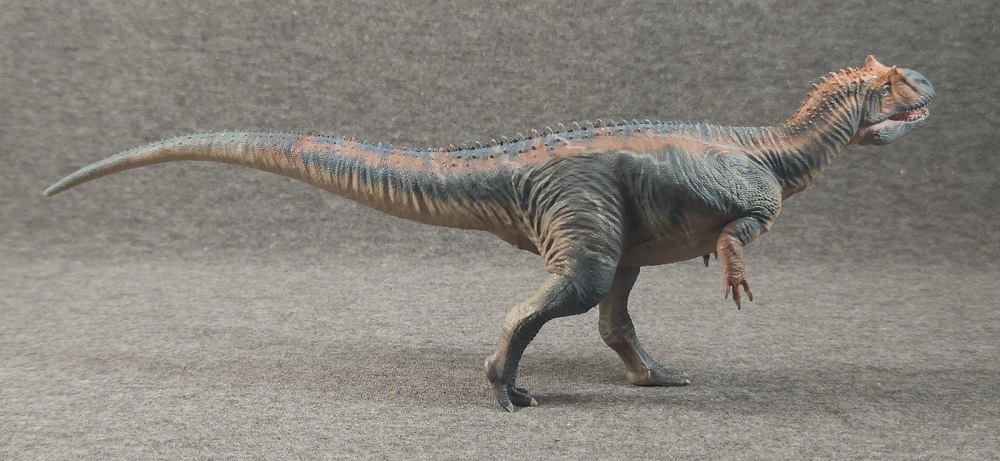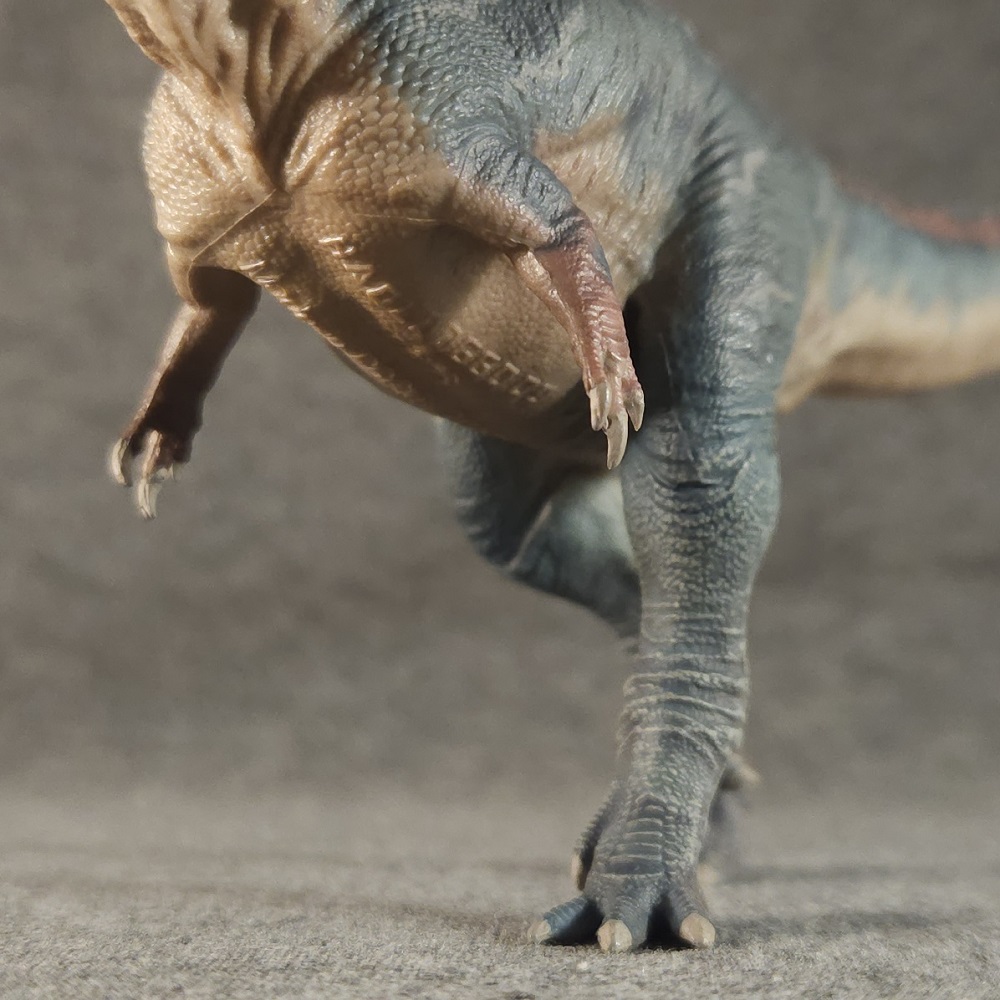My thanks goes out to Happy Hen Toys, who were gracious to provide a sample of YangZhi the Allosaurus for this review. YangZhi & SuoChao are the latest in a long line of Allosaurus toys, going as far back as 1955 and now numbering into the hundreds. Allosaurus remains a staple in the roster of most iconic dinosaurs ever, so collectors have rarely been left wanting for the animal’s representation. The catch to this is: with so many figures having already passed through the market, what does a new collectible bring to the table that prior items haven’t?

Allosaurus was Haolonggood’s first theropod release of 2023, a year the company started strong with a slew of herbivorous dinosaurs. Theropods were nothing new for Haolonggood – the majority of their earlier work was focused on this group – but Allosaurus was a notably smaller figure than previously featured genera. Each Allosaurus figure stretches 23 cm (9 in) from nose to tail; they’re a little smaller than current Safari Ltd. or PNSO offerings, but still generally fitting within 1:35 scale for an 8-meter-long live individual. Each paint variant is sold separately, as typical for Haolonggood, packaged snugly in a plastic wrapping and Styrofoam casing within a clean white box, decorated with appropriate photos and product details. No stand is included, but both of my figures have held up extremely well for several months on a regular shelf. It’s very satisfying to see companies getting so much better at mastering the balancing act for bipedal figurines.


Haolonggood continues to impress with the complexity of its paint jobs. The two Allosaurus have distinct color schemes (with some shared features), YangZhi being primarily blue and SuoChao being primarily red. Yangzhi is my personal favorite of the two; both figurines bear a creamy brown underbelly and additional striped highlights along the back, but the muted blues on YangZhi make the individual colors pop better, due to the complementary warm & cool values. Orange/pink stripes run parallel from the face down to the tail, decorated by squiggly white stripes isolated on the flanks and limbs. Not everyone cares for Haolonggood’s “squiggly” style, but I think they work well on this figure. SuoChao shares these white stripes, as well as the orange facial highlights; the parallel striping on the back is more of a dusty greenish-brown, with a little more emphasis on the spotted skin patterns and dark highlights on the lower limbs. Both paint jobs are attractive, and collectors can determine for themselves which version suits their interests more.


Detailing is also very good on these figures. While a few skin impressions exist for Allosaurus, they don’t give us the full picture of the animal’s integument, so Haolonggood’s artists are able to approach with a degree of artistic license. Most of the figures’ bodies are covered in extremely fine scaling (roughly representing what we know from the fossil impressions), with a few regions like the shoulders and rear jaws displaying larger scales. Rows of scutes and spikes also adorn the spinal region, giving the figures a slightly more dramatic silhouette. A lot of wrinkling is present across the body, perhaps a little excessively, but not so much as to revert to older elephant-skin renditions seen in toys before. Facial features are especially well-defined, carefully outlining the eyes, mouth, and skull structure. The iconic lacrimal horns are on full display here, and each tooth is individually sculpted. A careful look inside the mouth even reveals indentations on the roof for the internal naris, part of theropods’ unique respiratory structures.



Unfortunately, the definition of the facial features ends up highlighting the greatest flaw of the figurines. Although YangZhi and SuoChao are unmistakably Allosaurus, they are also unmistakably very outdated specimens of Allosaurus. The skull of these figures is reconstructed with a fairly short, rounded shape, hearkening back to early 20th century references that pervaded well into the turn of the century before new, more accurate appraisals managed to permeate the paleoart sphere. Current reconstructions of Allosaurus fragilis feature a more oblong skull with a pronounced jugal bone (the “cheek” region). There are other species of Allosaurus known, each with their own unique appearances; but the Haolonggood figurines don’t fit any of these particularly well (at least in profile view – from above or from the front, the skull looks more reasonably up-to-date). The skull is still too short, too deep, too rounded along the nasal bridge – and the jugal bone is completely flat, with no distinction from the maxila. On a lipped dinosaur this difference might be masked better, but Haolonggood opted for a lipless reconstruction, with the teeth fully exposed and pronounced scalation defining the line of the mouth. To Haolonggood’s credit, sculpting teeth and lips at a smaller scale was a challenge they were still overcoming at the time of these figures’ release; their Daspletosaurus and Megaraptor would later triumph in this regard. Nevertheless, the resulting design only draws more attention to the concrete anatomical errors present. The fenestra in the skull are also a little more prominent than probably necessary, giving YangZhi and SuoChao a gaunt portrait.


Elsewhere on the bodies, anatomy looks a lot healthier. If the skulls give the impression of an animal in lean times, the postcranial regions are much more indicative of rich feeding grounds. The two theropods are given stout, compact torsos with muscular tails, blending smoothly into the sturdy legs on which the figurines remain balanced. The underlying skeletal proportions seem to match up well with recent skeletals, as they should, given how much fossil material we have of Allosaurus to reference. One note of criticism I will make is that the arms appear undersized; Allosaurus had fairly large arms and fingers to grab prey with. Haolonggood could probably afford another 20% or so to the forearms and hands, with additional emphasis to the enlarged thumb claw (a feature often overlooked in Allosaurus toys even today). The individual fingers look good relative to each other, though, whereas the middle toe of the feet could probably be a lot longer.

YangZhi and SuoChao feature an articulated jaw, as is the case for most Haolonggood theropods. While earlier figures like Carcharodontosaurus and later figures like Megaraptor handle this feature satisfactorily, on Allosaurus the engineering leaves something to be desired. The hinge itself works just fine, but when closing the mouth there tends to be a light gap between jaws, giving the already bare-toothed dinosaur a slightly ghoulish appearance. Once again, it’s worth acknowledging this was a figure Haolonggood was still (ahem) cutting their teeth on as they experimented with different sizes of animals.


…So, at the end of the day, what do YangZhi and SuoChao bring new to the table? Well, maybe not much. While Haolonggood remain at the top of the game in balancing complex paint and price range, for Allosaurus selection there are other well-made figures that achieve better accuracy, with both cheaper and more expensive alternatives. That said, they still display nicely among fellow Haolonggood dinosaurs if one prefers a more visually consistent collection. I also feel these two manage to evoke imagery of artists like Todd Marshall, Gabriel Lio, and Brett Booth from the 2000s period of paleoart; if one is partial to this particular era of aesthetics, YangZhi and SuoChao might scratch that special itch. Although they may be flawed, YangZhi and SuoChao the Allosaurs get my recommendation, with appropriate expectations.

My thanks again to Happy Hen Toys for their generosity (and patience) to support this review; you can return their support by purchasing this pair, plus other Haolonggood dinosaurs and alternative Allosaurus figures, at happyhentoys.com.

Disclaimer: links to Ebay and Amazon on the DinoToyBlog are affiliate links, so we make a small commission if you use them. Thanks for supporting us!





If one looks at @Sims comment #3055 on the 2023 HLG thread, January 7 of this year, you’ll see that he shows a picture of an Allosaurus skull that HLG may have referenced in sculpting their Allosaurus in this fashion. He asserts that this skull shape is a legitimate option to use as a model, if somewhat atypical, I suppose. What do you think?
Great review! You articulated the issues I had with the skull of the model beautifully. I could never figure out just what it was that was off putting about the face, but this is the only HG model I won’t try to track down.
Great review of an OK figure. One of the worst figures from hoalongood, yet a good one overall. 4 stars!
Good to see a review from you again! I don’t really like this figure but was feeling generous since HLG is such a fantastic company and this particular toy is a bit of a rough draft for better things to come. Four stars!
Thank you for reviewing them. Even some Allosaurs in the 90’s were slightly more accurate, but we can’t judge HG too harshly, as they were coming into shape. Now everyone can’t get enough of them! I don’t collect them since it would be a slippery slope, but I will get the Dilophosaurs when I can.